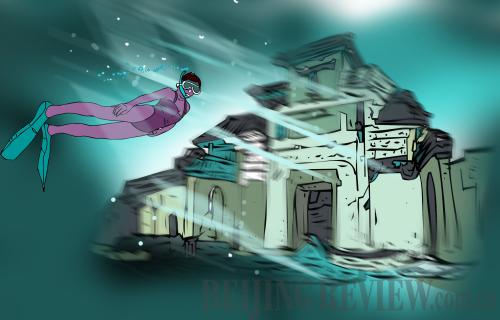|
 |
|
(LI SHIGONG) |
"During my eight years' diving experience, the ancient cities were the most beautiful scene that I have ever discovered underwater," said Liu Jinyong, manager of diving course of the club's Qiandao Lake branch. "Every time I swam into the cities and saw the painted rafters and carved beams, I felt as if traveling through a time warp," he said.
Remains of the city walls and gates were found about 30 meters beneath the water surface. They were the first to touch the submerged artifacts in more than 40 years.
Inside the ancient Shicheng City, the divers found wooden beams, stairs and brick walls of a number of houses still standing at the bottom of the lake. The surrounding walls of some larger houses were intact. Inside the houses, the painted rafters and carved beams remained visible.
Thrilled by the discovery, Qiu immediately reported the find to the local government. Since then, the ancient sites have come into view of the public and have been attached much attention. Further explorations have been continuously carried out. Before the live broadcast, a total of five explorations had been done.
In 2002, a joint underwater exploration was conducted again. The exploration team used manned diving robots, sonar detection and other technologies.
In 2005, the exploration team found that in addition to the two ancient cities, there were three towns named Weipi, Gangkou and Chayuan beneath the water. Still intact, the newly rediscovered sites constitute a complete map of the historic area. This further increased the archeological value of the discovery.
In November 2009, Wu Lixin, a professional underwater photographer entrusted by the Chinese National Geography (CNG), an authoritative geographic magazine of China, started photographing the underwater cities and towns. He dove to the lake bottom four times and took stunning pictures.
In February 2011, CNG published a set of Wu's photographs. The gallery once again aroused a wave of interest in the ancient cities across the country.
On January 7, 2011, the underwater Shicheng City was officially approved as a cultural relic under the provincial protection of Zhejiang.
The discovery that the underwater cities and towns were kept intact excited the local people. The development efforts have inspired debates in Chun'an, where Qiandao Lake is located.
Various proposals were brought forward, but very few were feasible, said Xu Xiangzhi, Deputy Director of the Qiandao Lake Tourist Administration.
Some suggested allowing tourists to dive down to the ancient sites, but the idea was immediately rejected because of the hazards for uncertified people in diving more than 7-8 meters below the lake's surface. To reach the underwater ruins, they would have to plunge more than 20 meters down. Mud at the lake bottom was another potential safety hazard.
Others suggested moving the ancient structures out of water and restoring the ancient cities on land, as attempted in some cultural heritage protection projects. The local government countered that there wasn't an area big or flat enough to house the original cities. Experts warned that the wooden buildings would easily decay after being removed from the water.
While these proposals were shot down in the discussion phase, a feasible solution was tentatively reached—underwater sightseeing by submarine.
Hangzhou Green Century Tourism Development Co. invested 40 million yuan ($6.35 million) to build China's first inland river sightseeing submarine. With 48 seats, the submarine is capable of diving up to 50 meters below the surface.
Since its completion in 2004, however, the submarine has never made a trip. It was not approved by the government.
| 